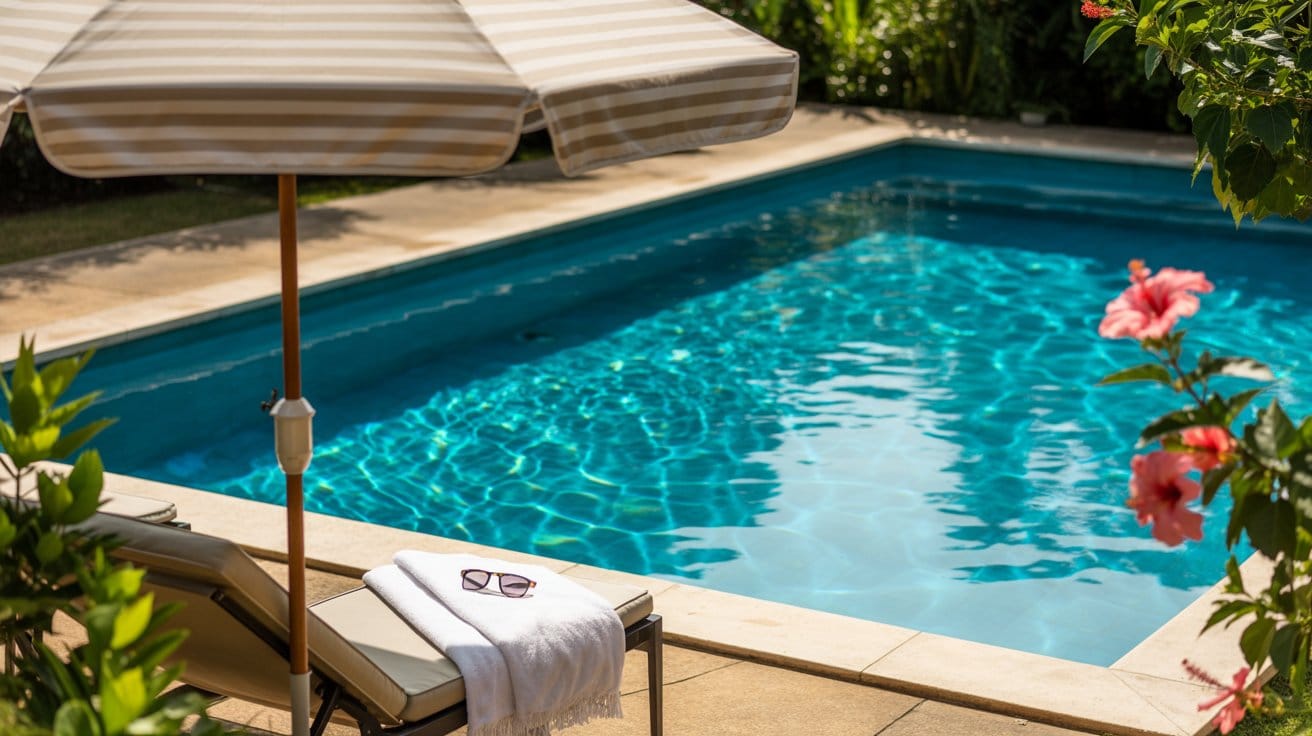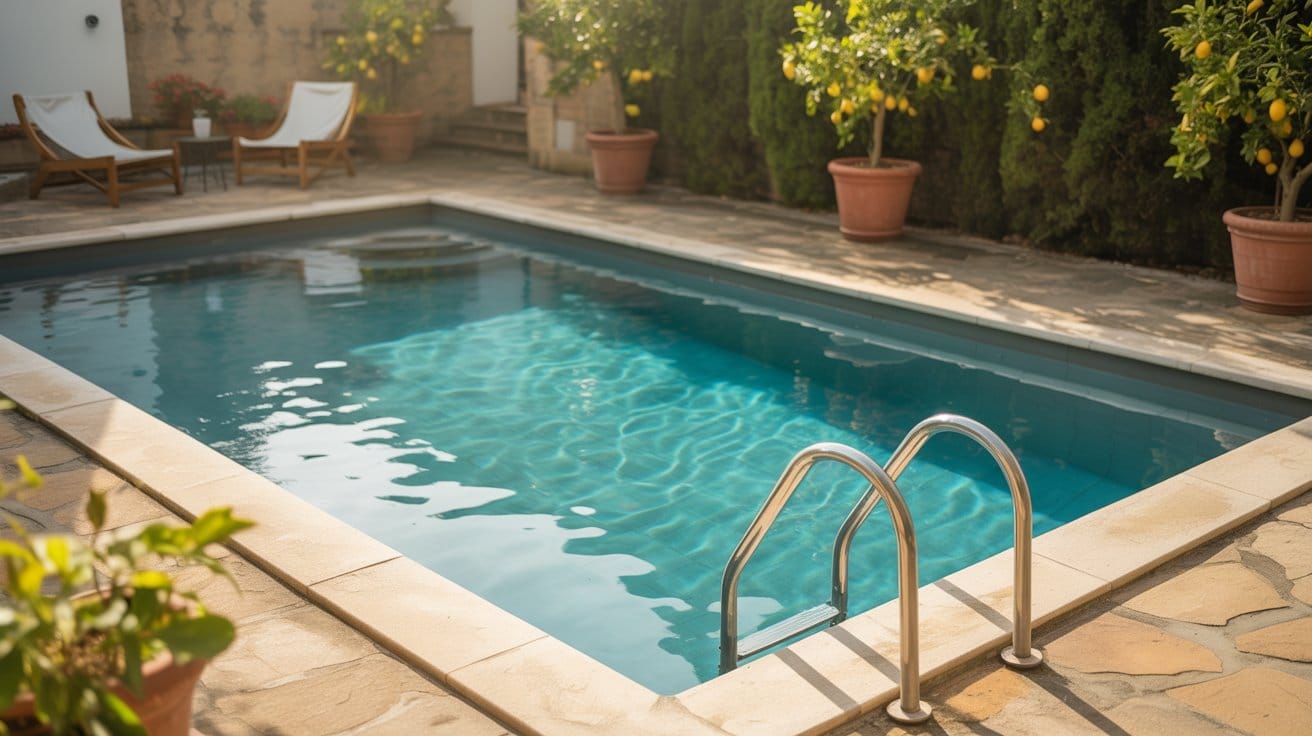Why Your Pool Loses Chlorine in Sunlight: Simple Solutions

Here's a surprising fact - sunlight breaks down 90% of your pool's chlorine in just two hours. Everyone loves relaxing by their backyard pools in the sun. Those powerful UV rays quietly work against your water chemistry though.
Your pool needs chlorine levels between 1ppm and 3ppm to stay healthy. Most pool owners don't realize how fast chlorine disappears from their pools in direct sunlight. UV rays drastically change how pool sanitization works, which means you need to adjust your maintenance schedule. The math is simple - you must double the chlorine for every 6 degrees Celsius above 27 to keep proper levels. Sunlight helps stop algae from growing, but it creates a big challenge by making chlorine unstable. Let me show you how sunlight changes your swimming pool's chemistry and share some budget-friendly ways to protect the chlorine you've added.
Why chlorine matters for your pool
Chlorine is the unsung hero of pool maintenance that works around the clock to keep your swimming experience enjoyable and safe. This powerful disinfectant creates hypochlorous acid when mixed with water and builds a resilient defense system that eliminates harmful bacteria, viruses, and other disease-causing microorganisms.
Pool safety depends on proper chlorination. Your pool can quickly become a breeding ground for pathogens that cause recreational water illnesses (RWIs) without it. The sanitizing power of chlorine eliminates dangerous bacteria like E. coli and Salmonella, along with viruses that cause diarrhea and swimmers' ear.
Chlorine's role goes beyond sanitization:
- The water stays clear because it stops algae from growing
- Your pool stays clean as it breaks down sweat and body oils
- The disinfection effect lasts throughout the pool water
You need the right chlorine concentration to make it work. The CDC wants pool owners to maintain levels between 1-3 parts per million (ppm). Most experts point to 1.5 ppm as the ideal level for effective disinfection. The pH should stay between 7.2-7.6 to maximize chlorine's sanitizing power.
Free chlorine shows how much sanitizing power remains active in your water. The sanitizing strength drops substantially when it changes to combined chlorine (chloramines). Your pool's free chlorine levels must stay higher than combined chlorine for proper disinfection.
Many people think a strong "chlorine smell" means too much chlorine—it's actually the opposite. Chloramines create this odor, which signals you need to add more chlorine. Testing becomes vital, especially when many people use the pool or during hot weather.
Poor chlorination creates many issues: cloudy water, eye irritation, skin rashes, and possible illness. Cryptosporidium bacteria pose a special challenge because they resist chlorine's effects. Regular checks and proper chlorine levels protect swimmers and equipment alike, making chlorine the lifeblood of responsible pool ownership.
How sunlight affects your swimming pool
Sunlight's ultraviolet rays create a big challenge for pool owners. Many people believe chlorine just evaporates, but it actually goes through a chemical change called UV degradation. Your pool can lose up to 90% of its chlorine within two hours when exposed directly to the sun.
The science behind this is fascinating. UV radiation gives energy that breaks down hypochlorous acid (HOCl) and hypochlorite ions (OCl-). These chemicals turn into useless compounds like hydrochloric acid and oxygen gas. Your sanitizer becomes worthless when this happens.

Temperature makes pool chemistry even trickier. You need twice the chlorine amount to keep proper levels every time the temperature rises 10 degrees above 80°F. Pools in direct sunlight lose chlorine much faster than those in shade.
Heat creates two big problems:
- Chemical reactions break down chlorine faster
- Bacteria thrive and eat up chlorine more quickly
Hot, sunny days can make your pool's sanitizer levels drop dramatically. Bacteria spread faster in warm water if you don't take action, which puts swimmers at risk.
Pool experts suggest you test free chlorine levels every 1-2 days in hot weather. Many professionals think daily testing works best to keep water properly sanitized.
Cyanuric acid (CYA), or stabilizer, is a great way to get protection against this quick breakdown. It creates a protective shield around chlorine molecules that reduces UV breakdown by a lot. The CDC wants you to keep CYA between 30-150 ppm, while most experts suggest 30-100 ppm works best without affecting chlorine's power.
Your typical home pool still loses about 1.5 ppm of chlorine daily from sunlight—around 10 ppm each week, even with good stabilization. Regular monitoring remains crucial, whatever preventive steps you take.
Simple Solutions to Protect Chlorine from Sunlight
Your pool's chlorine needs protection from the sun's destructive power. The right strategies can make chlorine last 3-5 times longer. This saves you money and reduces maintenance hassles.
- Use Cyanuric Acid (CYA): CYA works as your best defense against UV degradation. It creates a protective shield around chlorine molecules that stops them from breaking down in sunlight. Standard outdoor pools need CYA levels between 30-50 parts per million (ppm). Saltwater pool owners should maintain levels between 60-80 ppm, as recommended by the manufacturer. Chlorine exposed to UV rays without a stabilizer disappears quickly—half of it vanishes in just 17 minutes. Bright sunny days can destroy up to 90% of your pool's chlorine in a few hours.
- Increase Chlorine Application: Hot summer weather means you'll need double the chlorine to keep sanitization levels right. Regular testing (2-3 times weekly) helps you catch drops early and adjust chlorine levels accordingly.
- Use Pool Covers: A good cover blocks UV rays and stops chlorine degradation. These covers reduce evaporation by up to 95%, keeping your water and chemicals from disappearing. They also help keep debris out, reducing the demand on chlorine to clean up organic matter.
- Automate Pool Maintenance: Manual pool cleaning can be time-consuming, especially in summer when debris like leaves, algae, and dirt accumulates faster due to heat and sunlight. A cordless robotic pool cleaner can simplify this process by keeping your pool free of debris that consumes chlorine. For example, I recently tried the Aiper Scuba X1 Pro Max, a cordless robotic cleaner designed for in-ground pools. It’s equipped with powerful 8500 GPH suction and dual brushes to tackle algae, dirt, and fine debris on the pool floor, walls, and waterline. Its smart navigation adapts to different pool shapes, ensuring thorough cleaning without missing spots. Plus, the app control lets you schedule cleanings, so your pool stays pristine even on the hottest days. Reducing debris, it helps maintain stable chlorine levels, saving you time and effort.
- Test the Water Frequently: In hot weather, pool chemistry should be tested 2-3 times weekly. This watchfulness helps detect falling chlorine levels early. If you’re using a robotic cleaner with water quality monitoring (like some advanced models paired with tools like the HydroComm Pro), you can get real-time updates on chlorine and pH levels, making it easier to stay on top of maintenance.
Many chlorine products (trichlor or dichlor tablets/granules) already contain stabilizer. Users of unstabilized chlorine like liquid chlorine or calcium hypochlorite need to add CYA separately. Be cautious—high CYA levels above 50 ppm can reduce chlorine’s ability to kill bacteria. If CYA gets too high, partially drain your pool and add fresh water to dilute it.
Conclusion
Sunlight can deplete your pool’s chlorine by up to 90% in just two hours, making maintenance a challenge. Understanding how UV rays and heat affect chlorine helps you keep your pool safe and clean. Chlorine kills bacteria, prevents algae, and clears contaminants, but it needs protection to stay effective.
Simple steps like using cyanuric acid (30-50 ppm), adding extra chlorine during heat waves, and testing water 2-3 times weekly ensure proper sanitization. Tools like the robotic pool cleaners can also help by removing debris, reducing chlorine demand, and saving you time for more poolside enjoyment.
